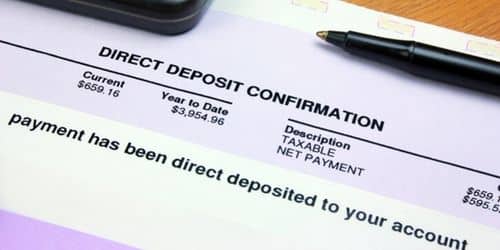Direct deposit means that money is sent to your bank account electronically instead of by check. When a direct deposit is used to put money into a bank account, no paper check is ever touched. This article talks about how direct deposit work on the cash app.
How Direct Deposit Works
For direct deposits to be processed, there needs to be an electronic network that makes it easy for banks to send money to each other. When money is sent electronically, it goes right into the accounts of the people who are supposed to get it. There is no waiting for the cash to clear. Direct deposit is a common way to get paid, get a tax refund, or get other types of benefits.
Direct deposit is a very popular way to pay because it is safe and easy. Using an electronic transfer system, money is sent right to the account of the person who is supposed to get it. To transfer money, the payee needs the payee’s bank name, account number, and routing number. They could even give you a void check that looks the same but doesn’t have any money on it.
Most of the time, it takes a few days to set up a direct deposit for payment. The information is put into the bank’s system after the depositor gets it. On the payment date, an electronic transfer makes a midnight deposit into the recipient’s account. The bank doesn’t have to put a hold on the money because ACH transfers are cleared and funded right away.
Find Out More About How Direct Deposit Can Work
Salary, tax refunds, withdrawals from investments, payments from retirement accounts, and government benefits like Social Security can all be transferred in this way. Creditors can also use direct deposit to get money from debtors. Taxpayers, for example, can choose to have their refunds sent to them by mail or put right into their bank accounts.
When a person files their annual income tax return, they usually get their refund within a few weeks. With direct deposit, the government can send back money to people quickly and easily. It’s the same with Social Security and other handouts from the government. Most direct deposits are done through banks and ACHs, but you can also use online banking and mobile phone transfers.
To send money right away to a loved one, for example, all you need is their email address and/or cell phone number. The person getting the money gives the service their bank account information. Once the money has been sent, it is put in the bank account of the person who is getting it. It’s just as easy as any other direct deposit because you can use the money right away.
Direct Deposit: Its Role and Its Advantages
Direct deposit can be used for a lot of different things besides payroll.
#1. Those Who Work on Their Own
Simply put, an independent contractor is a person who works for themselves and does “work for hire” for a customer. Since the law does not consider the customer to be an employer, it is not up to the customer to take taxes out of the contractor’s payment. Also, the client doesn’t pay the contractor on a set schedule. Instead, they pay after the contractor sends an invoice.
When paying independent workers, who are usually paid by check, direct deposit can be helpful for both the business and the worker. Contractors are usually paid at odd times, but with this method, you don’t have to wait for a check to arrive, be deposited, and clear the bank. Direct deposit is a way for businesses to save money on payroll because it gets rid of the need to write checks.
As of 2013, the only way to get Social Security payments is through direct deposit, not paper checks. The Social Security Administration estimated that switching to a direct deposit system could save $120 million per year. This would save taxpayers $1 billion over the past 10 years. People who don’t have a bank account can’t get their money through direct deposit. Most of the time, these people get their money on a prepaid debit card.
Direct deposit is a fast, easy, and safe way to pay child support. Most of the time, when a court orders a parent to pay child support, they set up direct deposit with their state. You don’t have to wait for paper checks to come in the mail when you have the option of direct deposit. This way of getting your money also doesn’t cost you anything. When child support is paid through direct deposit, it is easy to keep track of and look for it through online banking.
#3. You Get Tax Money Back
The IRS says that you will get your refund as soon as possible if you file your taxes online and choose direct deposit. When you file your taxes online and choose direct deposit as the way to get your money back, more than 90% of refunds are sent within 21 days. Paper checks can take a lot longer. And the IRS will let you split your return into up to three different bank accounts, so you can send your money exactly where you want it to go without lifting a finger.
#4. Making Payments
Rent and utility bills are two examples of recurring costs that can be paid by direct deposit. Most people set up this kind of direct deposit through their bank’s “bill pay” feature. Sometimes this is the only way to set up a direct deposit for a recurring bill because it can be hard to find out how to pay it directly from your bank account.
Who Can I Get Direct Deposit From?
People often think of the direct deposit as a perk of getting paid. Most people’s first experience with direct deposit is at their place of work. This is because switching to an electronic system saves money and time. If you sign up for the direct deposit, you can get money from more than just your employer.
The United States government, in particular, prefers to pay its citizens through direct deposit instead of paper checks. Since 2013, the only way to get a Social Security payment is through direct deposit or a prepaid debit card. In a similar way, instead of waiting up to six weeks for a check to arrive, you can choose to have your tax return directly deposited into your bank account.
Direct deposit is a safe and easy way for businesses, charities, and other groups to exchange money. It is used by a wide range of these groups. With direct deposit, you may not need to use paper checks as much or at all.
How to Use Direct Deposit and When to Start
Any payer can be used to set up direct deposit in the same way. Follow these steps to get money by direct deposit:
#1. Send in a Form for Direct Deposit
On most direct deposit forms, the employee has to write their name, address, and Social Security number, and sign their name to give their employer or another payer permission to make a direct deposit.
#2. Enter Your Banking Details
The most important piece of information on the direct deposit form is the information about your bank or credit union account. The other information listed above is also needed. Your company won’t be able to start the direct deposit until you give them the routing number and account number for your bank or credit union.
#3. Amount Paid Most of the Time
The amount you deposit will be the same as the amount of your check. Still, you might be able to split your money between your checking and savings accounts, like when you get paid.
#4. As Proof of Payment, Give a Deposit Slip or a Check That Has Been Cashed
Even if your banking information is on the direct deposit form, many companies still need a canceled check or deposit slip to make sure they are linking to the right account.
#5. Fill Out the Form
Because some of the information on a direct deposit form could be sensitive, care must be taken when sending it in. If you work in a typical office, you should send this form to the payroll office of your company. If you need to send this kind of form from far away, you should use a trusted file-sharing service instead of email.
How Does Direct Deposit Work On Cash App
With Cash App, a direct deposit work feature, you can move money from one bank account to another electronically. The direct deposit gets rid of the need to go to the bank and wait while you’re there. The most you can get in Cash App in one day is $50,000, and the most you can get in one transaction is $10,000.
If you use Cash App, your direct deposit work will be available as soon as they are processed, which is sometimes two days sooner than with traditional banks. Your company’s rules may make it take longer for your first deposit to be available.
Most of the time, it takes up to 5 business or work days for direct deposits to show up in your Cash App. But if you choose direct deposit, you can get your pay as soon as it is processed.
To make a deposit, you just need to put in your account number and the Cash App routing number. You can get to your bank account by using the account statements in your Cash App and your routing number.
Even though you might not always need to know it, it can be helpful to know the Cash App bank name. With the account and routing lines, you can use the Cash App balance to pay taxes, fees, or bills.
Please keep in mind that you may have to wait up to 7 business or work days for your Cash App direct deposit after you’ve uploaded your Cash App direct deposit form. Your direct deposit to Cash App is available the next business or work day, and you can use it to buy things at any Cash App location or at any of the millions of other places that accept the Cash Account debit card.
Advantages of Direct Deposits
Here are some of the good things about direct deposit.
#1. Streamlined, Super-Fast Money Transactions
Having direct deposit as an option has made it easier to bank. When you use direct deposit, you and the person you are paying don’t have to go to the bank as often. Most of the time, transferred funds are available right away or don’t take long to process. If you need to send money to someone quickly and don’t want to lose a paper check or cash, you could use an electronic direct deposit instead. In the same way, using direct deposits makes check fraud less likely to happen.
#2. Payroll Procedures Have Been Simplified and Streamlined
By switching to direct deposit, employers can save time and work on processing payroll and paying employees. Employees also benefit from this arrangement because their salaries and/or earnings are deposited directly into their bank accounts. This eliminates the need for manual cash transfers.
Disadvantages of Direct Deposit
Even though direct deposit and other electronic banking methods are becoming more convenient, they are also becoming more vulnerable to cyberattacks. Taking steps to protect online banking and other payment methods like direct deposits has proven to be very important. One type of cyber attack on financially sensitive data is a backdoor attack, in which criminals use a non-standard method to get into a database.
- Denial-of-service attacks are a type of cybercrime where an authorized user can’t get into the system because they keep putting in the wrong password.
- Direct-access attacks are those that get into a system and copy its data without going through a firewall. Bugs and viruses are examples of these kinds of attacks.
Does Direct Deposit Go Directly to Your Bank Account?
With direct deposit, you don’t have to wait for a check to clear the bank. You can get your money much faster and easier. When you sign up for a direct deposit, your paycheck will be sent straight to your bank account on the dates you choose. Direct deposit is an option for many kinds of payments, such as wages, unemployment benefits, tax refunds, and stimulus packages.
What Info Is Needed for Direct Deposit?
Each employee needs to give the name of their bank, the type of account, the account number, and the routing number. Before their employers can use direct deposit, employees in some states must also sign a consent form.
What Is the Disadvantage of Direct Deposit?
Electronic payments can’t be taken back as paper checks can. When switching banks, direct deposit information needs to be updated, which means employees need to fill out new authorization forms. Setting up banking and direct deposit accounting systems could come with some start-up costs.
How Do You Do a Direct Deposit?
You can use the following ways to:
- Fill out the form for the bank deposit.
- Put in your banking details.
- Reward amount.
- Include a canceled deposit slip or check as additional proof.
- Just mail the form in.
How Long Does It Take for Direct Deposit to Work?
If you choose to get paid by direct deposit, you should be able to get the money as soon as the bank opens on your payday (about 8 a.m.). Between midnight and 6 a.m. on the day of the deposit, which is usually payday, is the earliest direct deposits can be expected to reach bank accounts.
How Does Direct Deposit Work if I Get Paid on Friday?
Some businesses that pay their workers on Fridays have their paychecks directly deposited into their accounts on Fridays. This, however, may depend on the company.
Conclusion
Direct deposit is one of the most common and time-saving ways to exchange money. For this to happen, an electronic network called the automated clearing house must be used. The payee must either give their account information or a voided check in order to get a direct deposit payment.
How Does Direct Deposit Work FAQs
Is direct deposit immediately available?
Although direct deposits are typically handled and monies made available within minutes, there are occasions when this is not the case due to delays at the receiving financial institution. It may take two to three days for a direct deposit to clear. If your money is late, you should get in touch with your bank and the person who is supposed to pay you.
Which banks let you make direct deposits?
- Axos Bank.
- Chime.
- Current.
- Freedom First.
- OneUnited Bank.
- LendingClub Bank.
- Varo Money.
- Fifth Third Bank.
When do banks typically make direct deposits?
While the exact time a direct deposit appears in your account may vary from bank to bank, you can generally bet on it being there by the following business day at midnight. This is because a few hours after midnight, some banks update their customer accounts.
Related Articles
- BEST BANK FOR SMALL BUSINESS IN 2023
- Direct Method Cash Flow: Definition, Examples & Advantages
- DIRECT MAIL MARKETING: Everything You Need to Know!!!
- What Is Down Payment and How Do You Calculate It?
- THE TOP BEST BANK BONUSES: Practices & Tips in 2023






